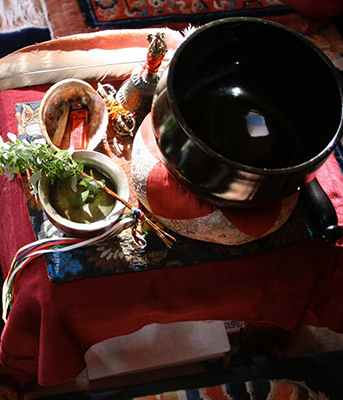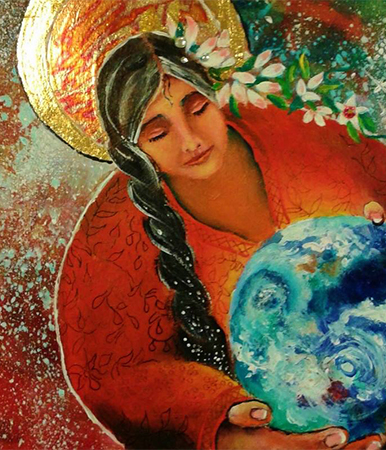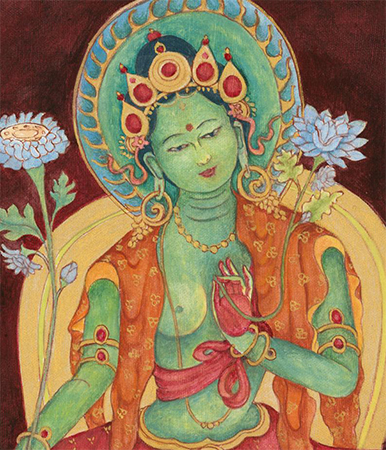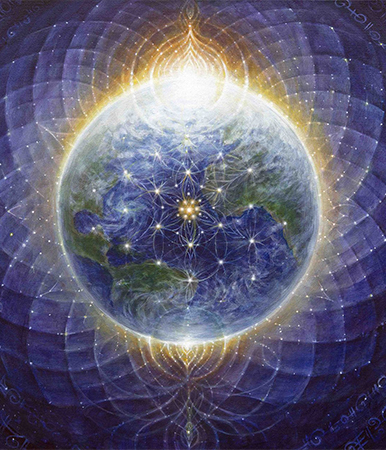GAIA MANDALA
GLOBAL HEALING COMMUNITY
Earth Treasure Vase for Lofa County, Liberia
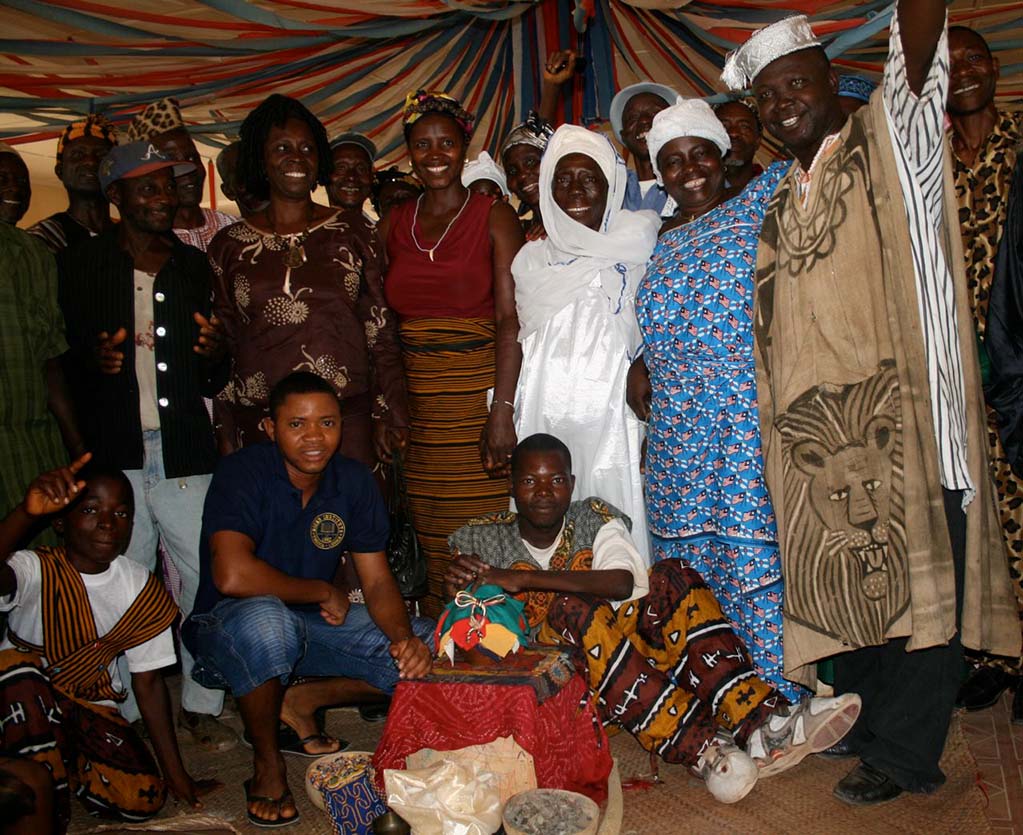
The community gathers for a photo after the Earth Treasure Vase ceremony in Liberia.
Introduction
‘’I had been contemplating Africa for years, visualizing the whole Earth and all the places that need healing and protection in order to know where to take the 30 Earth Treasure Vases I had been entrusted with by Charok Rinpoche. Somehow, if real healing of the Earth is to be accomplished, real peace is to be achieved and this spiritual practice from Tibet is to take root and be effective all over the world, then the indigenous elders who steward the lands we are visiting in pilgrimage with the vase, must be informed. We must make relations and their blessing must be sought for the ceremony to be successful. Over the years, we have tried to do this wherever we have gone, but Africa was another story; unfamiliar terrain and a world apart.’’ – Cynthia Jurs
The Earth Treasure Vase dedicated to Lofa County in Liberia has been a major addition to the Earth Treasure Vase Mandala. This Vase was destined to be the first of several sacred vessels to be dedicated and offered to the African continent. The story of this Earth Treasure Vase takes you into the heart of West Africa, traveling through Dogon Country in Mali to the destination of the vase in Liberia. Cynthia Jurs wrote a moving account of this significant, mysterious and sacred pilgrimage.
The story of the Earth Treasure Vase for Lofa County, Liberia
by Cynthia Jurs
The initial invitation
In October of 2008, my friend and advisor, Deena Metzger invited me to bring an Earth Treasure Vase to the closing ceremony of the annual meeting in California of a group called the Everyday Gandhis. This group is working with ex-combatants and former child soldiers in Liberia, along with women and indigenous elders, to bring healing to that land and to the people who have suffered a long history of oppression and injustice, especially in Voinjama —the worst fought area of a civil war that ended in 2003. Founded by freed slaves from the United States, Liberia had been governed by fighting warlords for too long but thanks to Muslim and Christian women who came together to stop the war, Liberia now has the first democratically elected woman president in all of Africa and has become a model of change… if peace can be sustained.
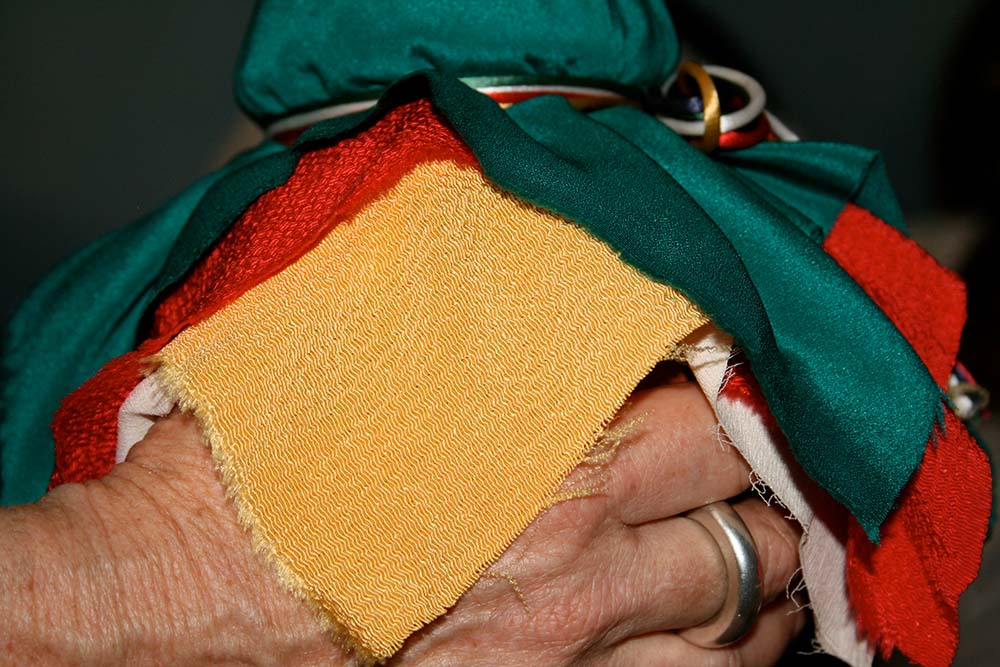

A guiding dream
Then I had a dream that I was trying to get from here to there across a bridge. I was caught in a bureaucratic underworld, going in circles. Finally I came up and out into the light and was met by an old friend, a spiritual sister and the founder of Pathways to Peace, Avon. She greeted me warmly and pointed to my luggage waiting by the carousel. I went to get my bags and was startled to see the vast night sky with many stars twinkling on the other side of a large plate glass window. Standing in front of me on the other side of the window, was an African woman wearing a red t-shirt under her jacket. She looked at me pointedly and opened her coat to reveal a constellation of stars printed on her shirt and the words, DOGON written below it. She gave me a look that made sure I understood this was a major communication and a key to my journey…I understood her to tell me, “The pathway to peace in Liberia is through the Dogon in Mali. Let the stars guide you.”
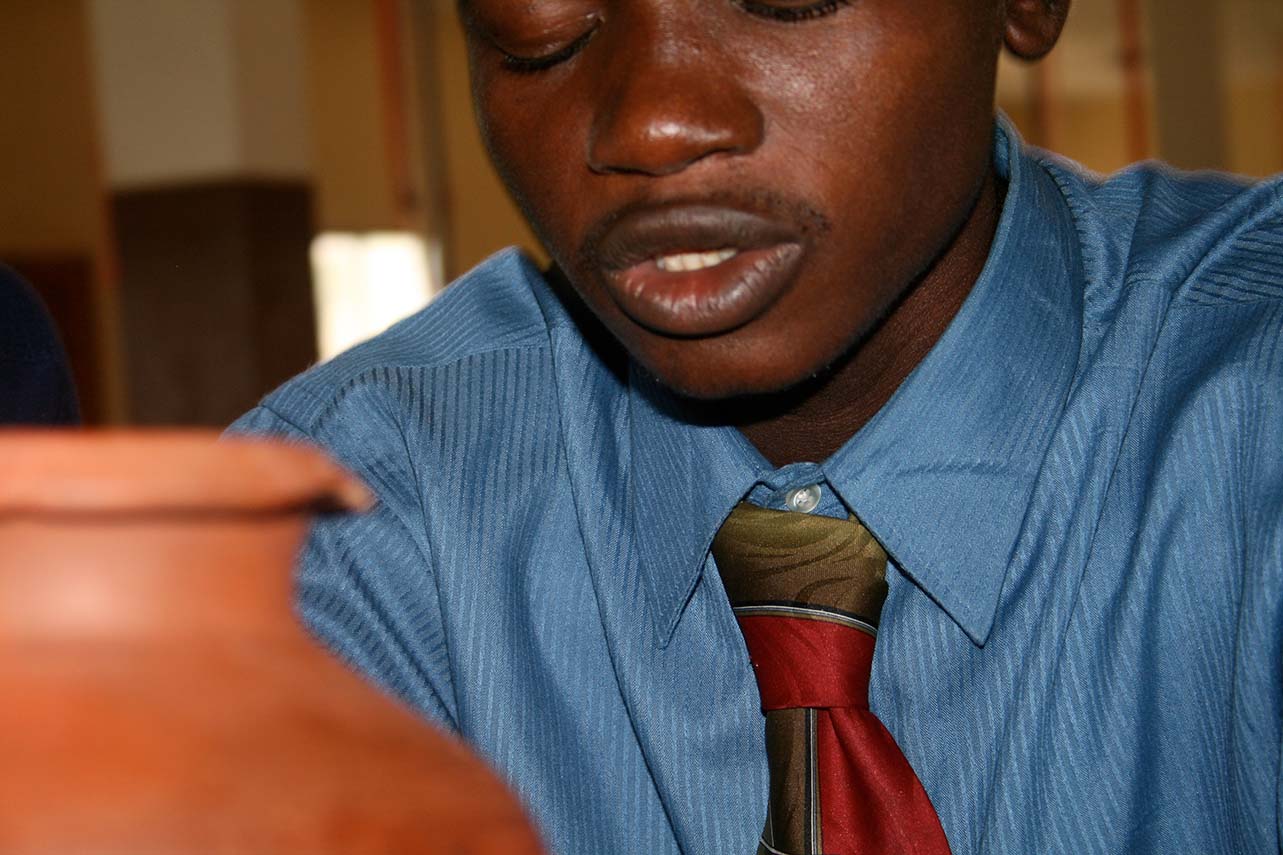
Pilgrimage to Mali (on the way to Liberia)




Dogon Country

His name was Guimolo Dolo and we found him waiting for us in his “office” – a dirt wash amidst rocky outcroppings just below his village. The sun was getting low, the light was still intense, and so was the heat. He is a Dogon priest, an elder and diviner who had made himself available to us because of the Earth Treasure Vase. Through Abdoulaye, he was informed that I was coming, and agreed to receive us for a divination and grant his blessing for the vase. As we approached, he was quiet, with kindness in his eyes and smiling face. His younger brother, also an elder and diviner, was with him.
The two of them prepared the dirt to receive my question and listened while I asked, “What do I need to understand in order to accomplish the practice of the Earth Treasure Vases?”
Of course, there was a lot to explain but luckily there were several translators on hand to help move from Dogon to French and French to English.

Early the next morning, with even more questions than before, I went back to the Dogon priest. We found him at the appointed hour again in his “office,” sitting on the brown Earth, his skin and bare feet like the surface of the nearby rocks, the fabric of his brownish-grey robes frayed with wear, melding into the landscape of which he was a part.
There was very little separation between this elder before me and the land itself. I was reminded of Charok Rinpoche who, after 100 years of meditation in his Himalayan cave, seemed inseparable from his robes and the cushion he sat on, the place he inhabited; so little of ‘him’ left.

The priest poked at the sticks and pointed out the tracks the fox had made. Looking closely, conferring amongst each other, finally he spoke.
“The way is open and clear, there are no obstacles to your path. You are blessed and supported in this work. The spirit is with you and it is a good spirit.”
Then he told me, “There are three countries in Africa that you will go to with the vase.” (He did not know that three vases had been designated for Africa, nor did he know that on this pilgrimage we were visiting three countries in Africa – Mali, Ghana and Liberia). He added, “and there are four countries where the support to accomplish the vases will come from in addition to the United States.”

I kept asking for him to elaborate, to say more, but he repeated the same simple response: “You are blessed. You are supported. The way is clear. There is a good spirit here. There are no obstacles.” As I questioned him with the help of my friend and translator, Oury, I came to see my lack of faith and disbelief that indeed this practice is utterly blessed and I am supported.
He invited us to bring the vase to his home in a village on the outskirts of Sangha* for the blessing ceremony. We made our way through the central courtyard where goats and chickens and dogs scampered, children played, and the women of the household, like all the women in all the Dogon villages at that season, were pounding the recently harvested millet that was piled on all the rooftops. We were ushered to a back “room” of mud walls, straw on the ground and only partial walls, more like a stall, where we sat down and brought out the vase. Next to where the old man sat was a small carved wooden door that he opened. He brought out his fetish. I was given some small sticks to hold and was instructed to concentrate on putting everything I sought a blessing for into the sticks. He insisted that I should not leave anything out. I concentrated with all my heart on every aspect of the Earth Treasure Vases, the journey ahead to Liberia to bury the vase we had brought with us, this incredible healing prayer for the Earth that I was given so long ago, my dwindling resources with seven vases still left to bury and the big Earth changes upon us …


When at last I felt complete, I gave the sticks back to him. He inserted them into the fetish, an oblong egg-shaped mass of dark-colored, mysterious stuff about twelve inches long and six inches wide, and returned the fetish to its sanctuary on the other side of the small door. Then he asked for the vase. He brought out a bottle of brown liquid and poured some onto a flat stone he held in his lap. While he tenderly held the vase, he wiped the liquid around the inside neck of the vase with his finger. He gave the vase back to me to seal with the cork, silks and ties. We passed it around our small gathering and for one last time he took it, placing it gently inside the little door of his sacred sanctuary, touching it to the threshold three times while praying. At last he turned to me and said, “It’s done.”
I must have looked perplexed, because he asked if I had any questions! This began a long and awkward attempt to ask him about his tradition, about the times we are living in, and his guidance for the practice of bringing healing and protection to the Earth. He listened patiently and then spoke. He told me again that the vase was blessed and that I will be able to do it all. He said, “In three years time you should return to thank me!” (Again not knowing that our impossible wish has been to accomplish the last seven vases by the year 2012). The old man suggested I pray to a “certain bright star in the sky” which I took to be Sirius, a star the Dogon have a special relationship to, and pray to the rising and setting sun every day. And he told me that I could bless people now. He told me to remember the fetish whenever I need a direct link to the prayers and blessings that were made and went on to say that I should pay attention to the signs and omens. Most importantly, he told me to trust my own guidance now — that I will be protected.
“Your intentions are pure. Make offerings regularly to keep the prayers alive…and always remember that helping others is an offering.”

Struggling to take it all in, I asked him about the sense of urgency I feel, and the pressure to get the job done before it’s too late. He looked into me, then with his kind heart and calm eyes and said, “Time is not really an issue. We have no sense of urgency here like you do in the place you come from.”. I understood that they are simply not conditioned by time in Dogon Country, the way we are. “You need to trust that all will be taken care of.”
He was quiet and thoughtful, then added, “This work to maintain balance and harmony is what we have been doing all along. It has been kept secret and has not been shared, but it is what we devote ourselves to all of the time. We have done this forever and we will continue.” I felt myself relax inside with the sense of timelessness that he was pointing to.

We said goodbye. In my heart I prayed to return in three years and thank him as he had requested. Back in my room, the tears finally came — tears of gratitude, tears of relief and tears of great humility, to feel so seen and supported by this humble Dogon priest living in another world, another time. In all the years of teachings and empowerments from beloved Tibetan lamas, I had never received a blessing like this. I wanted to let it in completely; let his words take root. All I could do was cry.
I will never forget how, when I thanked him, he gave me such a look of loving kindness, blessing, appreciation, support, and recognition. I felt this old man of the land, of this Earth, of this ancient and mysterious culture, somehow also thanking me. What calm, what serenity, and what great kindness he showed to me, pouring out of his eyes and into my heart. In the end, I reached out my open hands. He took them and spit in each one in what seemed like a final act of generosity. I stood and bowed as he sat unmoving on the ground radiating peace.
Departing Dogon Country
We drove like the wind across the sands to visit other villages before leaving Dogon Country. Our distinguished guide Abdoulaye brought us to many beautiful villages, including Yougapiri where the Tellem caves are accessible high above, and some are still inhabited. I hiked up to the cliffs where I could feel the land and ancient culture more closely. Looking out over the vastness of that place, feeling the ancient wisdom still alive in the rocks, I contemplated the land and the amazing people I had met. We made our way over rolling hills along the Bandiagara escarpment to Ende. The road on the desert sand became a track, then only a mere trace with the ancient Tellem caves bearing witness from above — the mystery of their long ago wisdom kept alive through ceremonies and rituals the Dogon continue to uphold. I felt a palpable sense of peace all around me and realized it is truly one of the most beautiful places on Earth I had ever visited – one of the most intact, old peaceful cultures to have survived. In fact, I think it could be a beyul*.

Pilgrimage in Liberia

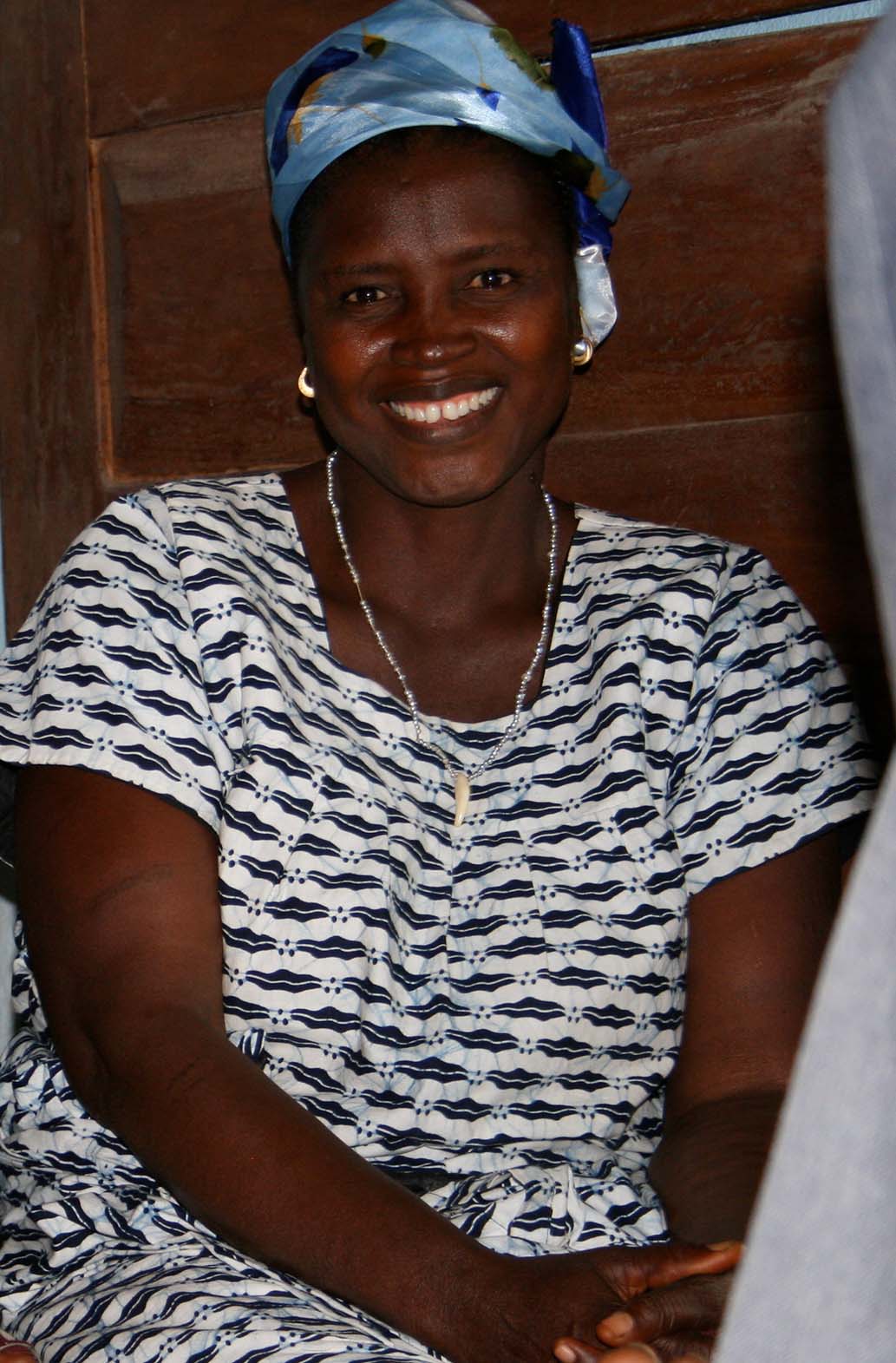
Leaving Monrovia, we traveled by Jeep on a road that was not a road, for 12 endless hours before reaching Voinjama, the base for Everyday Gandhis near the borders of Guinea and Sierra Leone. We were greeted by numerous Everyday Gandhis staff members who had waited up for us, offering warm hugs, hot water, and a special handshake that told us we were home. From the moment I arrived, I felt such a strong connection to the women, especially a wonderful healer and diviner named Mahwen Gayflor, who on one of the following days performed a divination in her house. I watched as she sat with legs outstretched, tossing cowrie shells and many other gathered objects from her bundle, on a straw mat in front of her in a small mud and thatch room, offering guidance from the ancestors.
The beautiful women, Mama Kaneh and Hawa Kamara, ran the Everyday Gandhis guesthouse while pursuing their own peace-building work with ex-child soldiers and former combatants in the area. Esther Kpaku, a former child soldier, now a ‘future guardian of peace’ with Everyday Gandhis, used my still camera to photograph everything. (One of the programs of Everyday Gandhis is to train the young people in photography and empower them to tell their stories). I sat on the porch one precious afternoon talking with Mahwen and Farbalee, the amazing drummer and leader of the culture troupe, before Lassana Kamara came and scooped me up for another meeting I had with the various groups of interested members of the community wishing to hear about the Earth Treasure Vase.
Kamara served as a local community liaison to organize and facilitate gatherings to invite the acceptance and approval of the Earth Treasure Vase from the local traditional leaders, both young and old. He worked hard to organize the many elders, officials, women, youth, and visiting dignitaries from Guinea and Sierra Leone to come together around our shared intention for the vase, taking great care to include everyone so that there were no mysteries or misunderstandings around the purpose of the vase, all according to tradition.
Kamara also took me to a local carpenter to make a wooden box to bury the vase in, and to a blacksmith who attached some old copper on the inside lid of the box, to conduct the energy of the prayers from the vase out into the Earth, as is traditional.


One evening, Mahwen and her assembly of women performed an important dance ritual to invite the ancestors and ask for their blessing and guidance around the Earth Treasure Vase.
As the women entered a trance, the ancestor spirit of the late Paramount Chief* came and told them that the work I was bringing was very important. He said they should take what we were doing seriously and that the ancestors were very happy about it. I found it interesting that it was the late Paramount Chief who communicated this because as it turned out, after much conferring amongst all the elders about the burial location, the site that was chosen was the village of the current Paramount Chief. It seemed that all members of the community, both living and deceased, naturally understood the purpose of the Earth Treasure Vase and were in favor.
The Final Ceremony
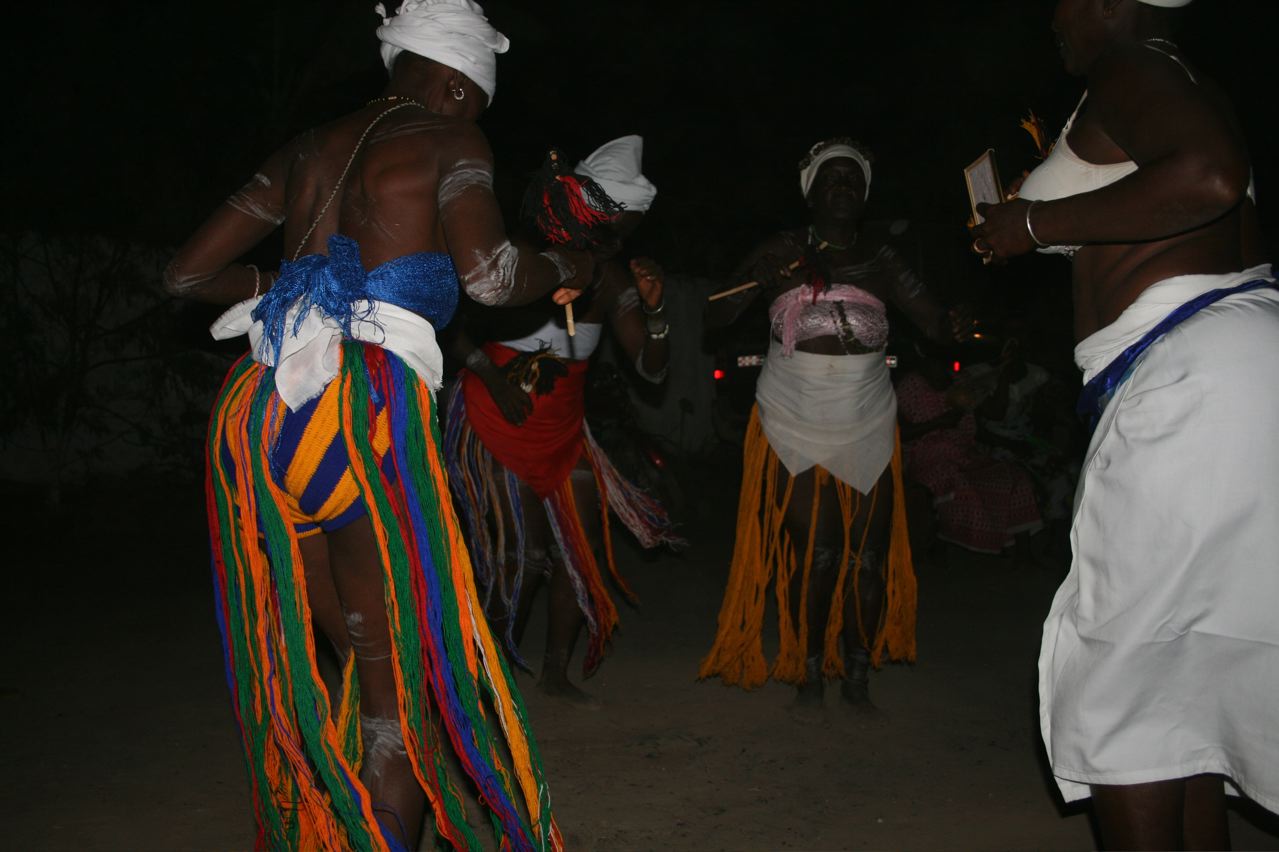

There must have been close to five hundred people at the final ceremony! All the government officials and chiefs, three representatives from Guinea and two from Sierra Leone, staff members of everyday gandhis, many women, many children, ex-combatants and former child soldiers, the culture troupe with all their drummers and dancers – everyone was there. It was a huge circle inside of a big empty hall… and it was thrilling.

There was singing first, then a welcoming by Kamara and Bill, after which I was asked to speak about the Earth Treasure Vase, this ancient practice coming from faraway Tibet. I was honored to ring the bell and invite all present to join together in meditation before sending the vase around the circle to receive people’s offerings and personal prayers. The guided meditation had to be translated into three languages for everyone to understand, and although the circle was large, the people were attentive during the long translations. Finally, the vase was opened and passed, warm hand to warm hand, all the way around the circle.

As the vase traveled and was held by everyone, each took the opportunity to make an offering and add their own prayers for peace. It was beautiful to see Master General accompanying the vase the entire way around the gigantic circle, overseeing it, protecting it, making sure it was passed with care and attention and handing it to the next person if it was a far reach, maintaining his concentration on it throughout. He seemed to know just what to do without us ever exchanging any words.
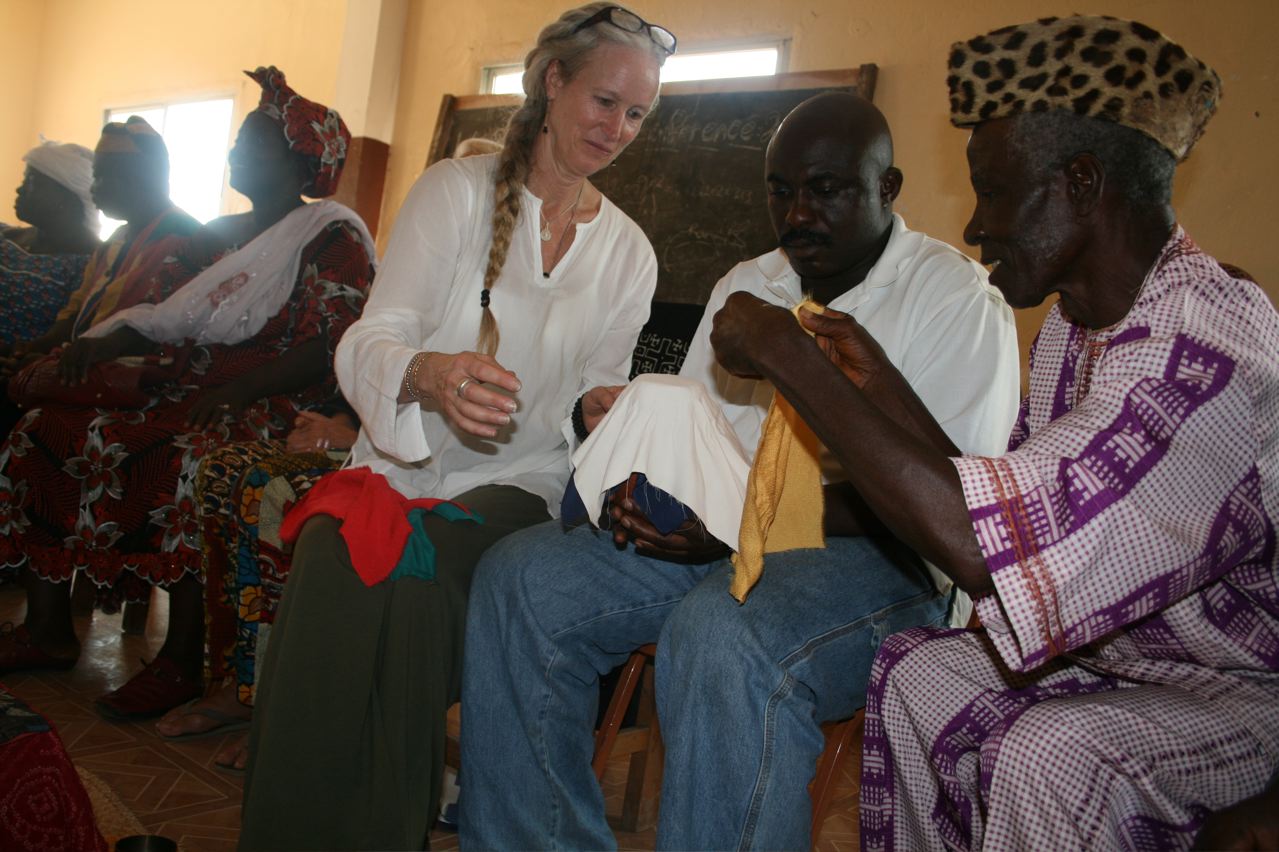
As the drumming continued, people began to gather around the vase. We paused to take some photos, and then it was time to put it into the box. Mahwen came forward to help me and there was a wild crush around us as the vase went into the box. I had a red scarf from Deena Metzger and three white katas (Tibetan ceremonial scarves) to wrap around the vase and many bags of herbs, flowers, rice and other things to pack around it. With each new bag of offerings it seemed a hundred hands reached in for something to add into the box as an offering. I wished I had had a lot more to share. When we used up every last bit, the box lid (with the copper inside) was closed, the little padlock secured by Mawhen, and the key deposited securely in her pocket.
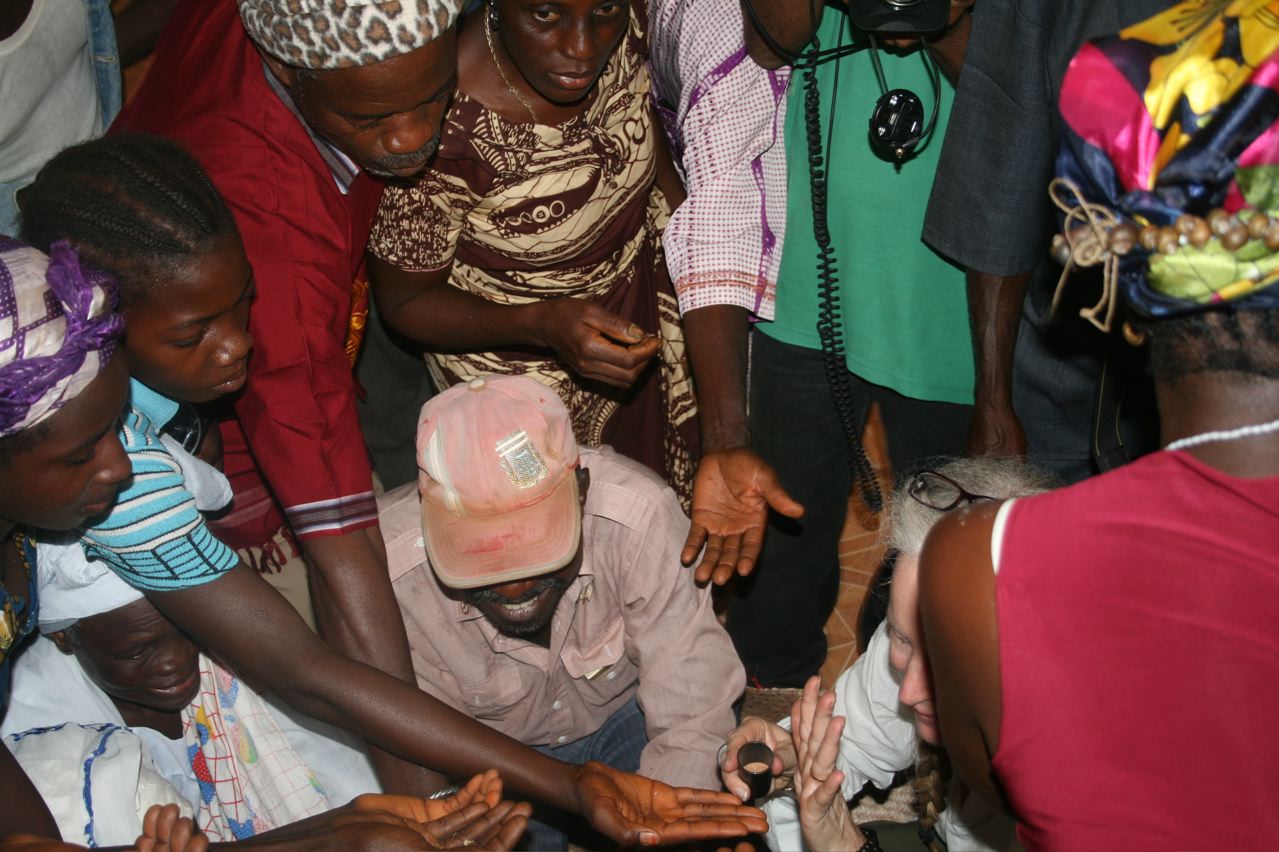
It was done. Everyone scooped up the box and we all began to dance with the box held high and much enjoyment all around. We danced to the singing and drumming until we all made our way outside, the celebration continuing even as we loaded into the vehicles to go back to the compound for lunch where many ate the meat that had been cooked since the morning’s sacrifice from a common bowl.
The Earth Treasure Vase Burial


The committee of elders asked if there were any special instructions for the vase once it was buried. I told them normally it is buried in a place no one would know, but in this case because so many members of the community had become involved, I hoped that the burial location would now become a place of refuge – a pilgrimage place to remember the prayers for peace and strengthen our collective intention that those prayers take root and grow strong, bearing much fruit in the years ahead. I did suggest that to show proper respect for the vase it should not be stepped on and that the actual burial spot should be protected. Someone suggested putting cement over it but we quickly decided it would be better if the land and roots could breathe. Together we imagined that a bench could be constructed all the way around the tree that would protect the vase and provide the beginnings of a place to gather at the heart of the village. Bethelson and the Everyday Gandhis team is already at work with the community to develop a little peace garden there, the beginning of the envisioned Heritage Center.
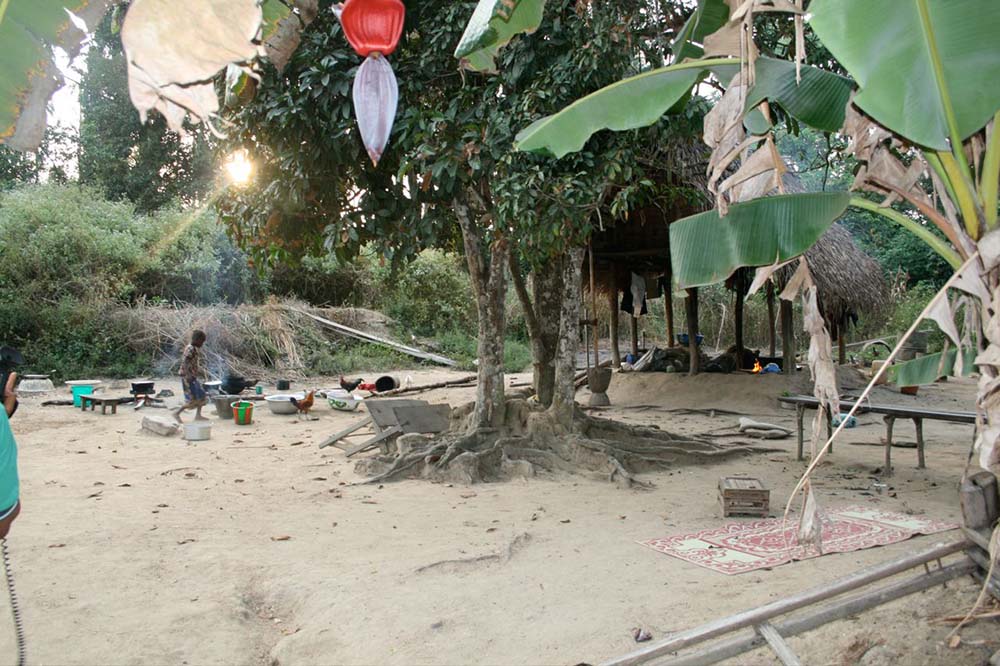

Uncle Jake, Christian Bethelson, and our pilgrimage videographer, Harper Karmon

Footnotes
- The Dogon of Mali are a mysterious ancient tribe, remarkable for their knowledge of astronomy. Some say that they were once visited by intelligent beings from the star system Sirius who imparted the knowledge and wisdom that informs their culture. Many of these claims have been the focus of sharp disagreement. Of particular contention is the fact that the Dogon knew of a white dwarf companion star to Sirius long before its presence was detected by conventional astronomy. Critics say it is impossible to verify these claims and that any special knowledge the Dogon might possess could have been passed on to them from sources much closer to home. From 1931 to 1956, the Dogon were subject to investigation by a pair of French anthropologists, Marcel Griaule and Germaine Dieterlen, who spent much time with the Dogon, finally winning their confidence and learning many of the tribe’s innermost secrets. Their books, Conversations with Ogotemmeli: An Introduction to Dogon Religious Ideas and The Pale Fox, both published in 1965, left little doubt that the Dogon were privy to astronomical knowledge that was hard to explain but neither Griaule nor Dieterlen ever made any claims about an esoteric source for the Dogon’s knowledge.
- Sangha is the name of one of the larger Dogon villages, not too far from the old man’s “office.” I found it interesting because “Sangha” for a Buddhist means the “community that practices harmony and awareness” and is one of the Three Jewels (along with the Buddha and the Dharma) that one ‘takes refuge’ in when following the path of awakening.
- Beyul: secret or hidden land; a paradisiacal realm in remote parts of Tibet and the Himalayas described by the Himalayan Buddhist elders in sacred texts. These havens are places where peace, prosperity, and spiritual progress are facilitated. They often transcend political boundaries and the exact geographical locations of beyul are often debated because their locations are also spiritual.
- Paramount Chiefs: Liberia has a complex system of regional chiefs and tribal customs and there are many “paramount” chiefs all over Liberia.

